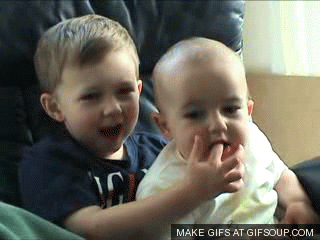One sunny afternoon in my childhood, I was inside watching a movie (like all good little film nerds do). That movie was "Labyrinth", which I had seen at least ten times before. After it was over, instead of going outside and playing catch or whatever normal, healthy children did, I decided to watch all of the special features. I don't really remember much of it, but one thing did stick with me to this day. In one extra, Jim Henson said that he had been told to never work with children, animals or puppets. And yet, "Labyrinth" involved all three, and look how that turned out. Although Henson admitted the process had been extremely difficult, as a viewer, the end result was so worth it.
Fast forward about eight years, here I am in Fiction Field II directing a film mainly consisting of children between the ages of six and thirteen. Immediately, Jim Henson's words came back to me and panic set in. After going through the five stages of grief at the thought of working with kids, I dried my eyes and decided it was time to buck up and prepare.
I took out my laptop and searched on the ol' Google tips for working with children. After sifting through multiple articles teaching parents with child actors how to "deal" with directors, I finally found some useful information. Here's a few things to keep in mind if you ever decide to work with tiny humans, from research and my own experience (with the assistance of hilarious gifs):
1. Safety:
 It's bad when anyone gets hurt on set, but when it's a kid, you're in a whole other world of trouble. This is why you should always take extra precaution and preventative measures when working with children. First, you should always have a parent or guardian on set with the kid. This way, not only will you have an extra set of eyes looking after them, you can talk to the guardian directly if you need anything or if anything goes wrong. Speaking of supervision, you should always have a member of your crew watching the children (it would be best if you hired someone specifically for this job). Legally, you are required to have at least one supervisor on set for every twenty kids, but you should make your life easier and have at least two. Make sure this person is not only comfortable with children, but is also talented at keeping them entertained and capturing their attention. Additionally, a second person can help walk the children between the waiting area and the set when it is their turn to be on camera. Next, you should ALWAYS have the parent or guardian sign a waiver and release form. This way you're less likely to lose a lawsuit if an accident does occur on set. Lastly, if your shot in any way endangers the child, forget about it. It's not worth it, and I'm pretty sure it's illegal.
It's bad when anyone gets hurt on set, but when it's a kid, you're in a whole other world of trouble. This is why you should always take extra precaution and preventative measures when working with children. First, you should always have a parent or guardian on set with the kid. This way, not only will you have an extra set of eyes looking after them, you can talk to the guardian directly if you need anything or if anything goes wrong. Speaking of supervision, you should always have a member of your crew watching the children (it would be best if you hired someone specifically for this job). Legally, you are required to have at least one supervisor on set for every twenty kids, but you should make your life easier and have at least two. Make sure this person is not only comfortable with children, but is also talented at keeping them entertained and capturing their attention. Additionally, a second person can help walk the children between the waiting area and the set when it is their turn to be on camera. Next, you should ALWAYS have the parent or guardian sign a waiver and release form. This way you're less likely to lose a lawsuit if an accident does occur on set. Lastly, if your shot in any way endangers the child, forget about it. It's not worth it, and I'm pretty sure it's illegal.
2. The Child Comes First:
 This kind of goes along with safety, but I thought it deserved it's own category. When you're on set, the needs of the child comes first. If they're tired, sad, hungry, etc... it's your job to accommodate to them. Maybe you need to take a few more breaks than planned, or maybe the kid just needs a bag of skittles. It's important that the child is happy, just as it is important to keep all of your actors as happy as you can. But, don't let them bully you. Additionally, if the content makes the child uncomfortable or confused, it's a good thing to make sure they know that it's not real, especially if they're younger, or pretend that something else is going on in the scene. For example, for Black Butterfly (my Fiction Field I film), we had a scene where a young child witnesses her mother's suicide by hanging. We had our mother actress holding onto a bar as we shot her legs, then we shot the girl's reaction. Instead of telling her that it was a suicide scene, we explained to her that the actress was just doing gymnastics, which put her at ease.
This kind of goes along with safety, but I thought it deserved it's own category. When you're on set, the needs of the child comes first. If they're tired, sad, hungry, etc... it's your job to accommodate to them. Maybe you need to take a few more breaks than planned, or maybe the kid just needs a bag of skittles. It's important that the child is happy, just as it is important to keep all of your actors as happy as you can. But, don't let them bully you. Additionally, if the content makes the child uncomfortable or confused, it's a good thing to make sure they know that it's not real, especially if they're younger, or pretend that something else is going on in the scene. For example, for Black Butterfly (my Fiction Field I film), we had a scene where a young child witnesses her mother's suicide by hanging. We had our mother actress holding onto a bar as we shot her legs, then we shot the girl's reaction. Instead of telling her that it was a suicide scene, we explained to her that the actress was just doing gymnastics, which put her at ease.
3. Directing:
All children are naturally little actors, so getting creativity out of them is usually not the problem. But when you need to give them specific direction, you're going to need to adjust how you speak so that they can understand. It's much easier to give them simple direction, "walk slowly to this spot" or "count to two Mississippi and then put your head down", than to give them motivation for their character. Or, if the child is particularly intelligent or theatrically trained, giving them simple motivation can also help. "Your mean sister just stole all of your candy, and you haven't gotten a single piece all night, how would you feel?" Putting the motivation in a question form allows them to think how they would react in the situation and give a more realistic performance. Being a director, you have to be authoritative, but not mean or scary. You have to find a happy balance between being their friend and someone they listen to. Be friendly and fun, but when it comes down to shooting, they have to be attentive and listen to what you say. When it comes to the shot, you usually can't get the same performance twice. Continuity means nothing to them, so you must plan your shots around that. Or if continuity is extremely important, make sure they know exactly what to do with their body and have a very attentive script supervisor watching their every move.
4. Camera Angles:
Children are short. It's a thing. Unless they ate some Popeye spinach all their life, you have to account for how you're going to shoot them in relation to adults and locations. If you want to make them look weak and sad, shoot them from above. If you want to make them powerful, shoot them from below (if you can). These are basic. But, it's important to film them at eye level for normal scenes so that you can get the right mood. Shooting at the child's level adds warmth and friendliness to the scene, rather than a striking angle. Additionally, when shooting a close up on a kid, it's better to move the camera closer and use a wide lens rather than zooming in.
Needless to say, after this weekend, my next film will star adults... But children are great. Really, they're great.






No comments:
Post a Comment